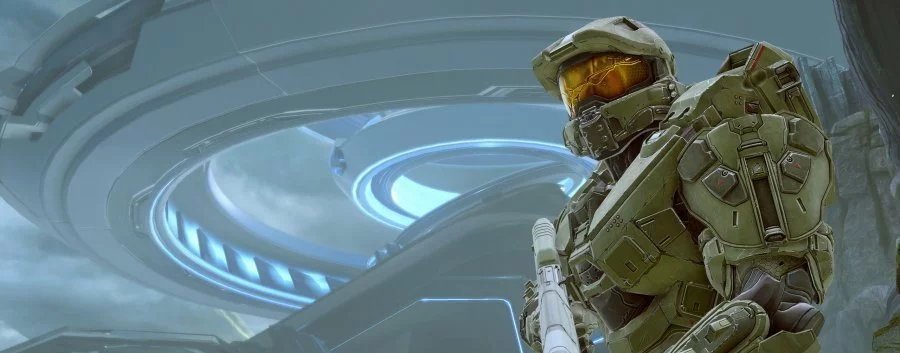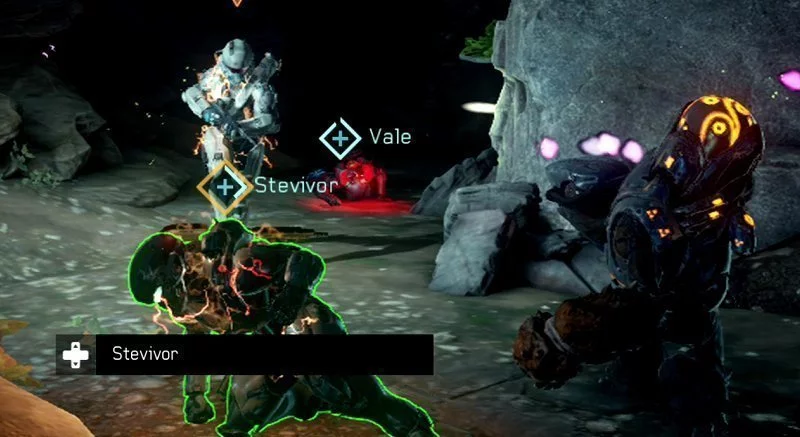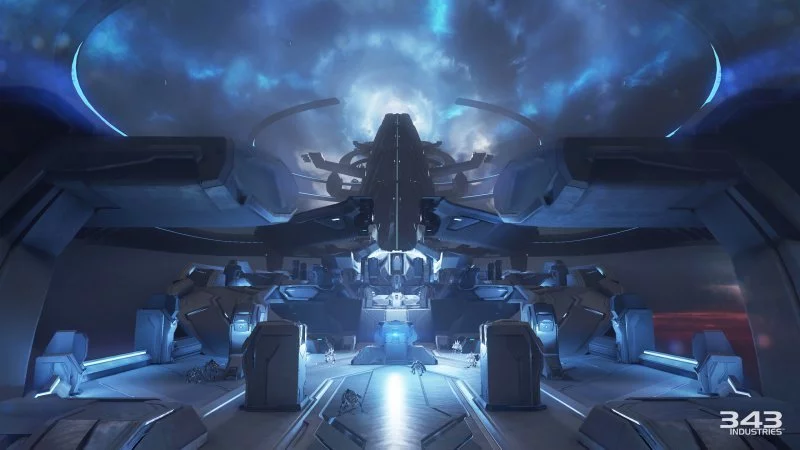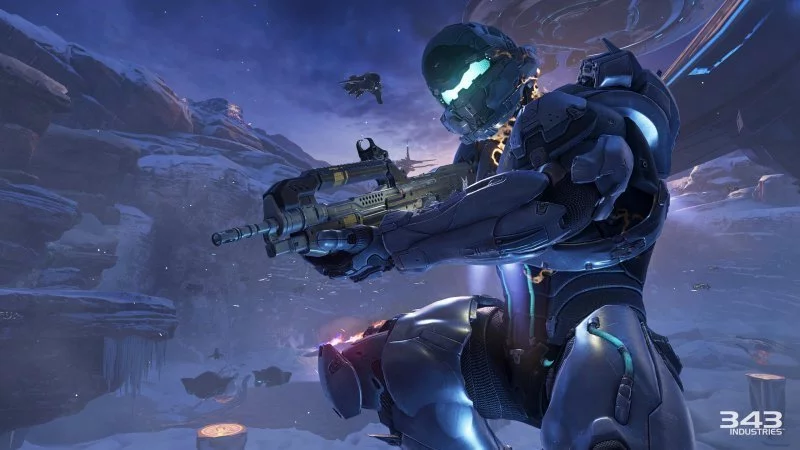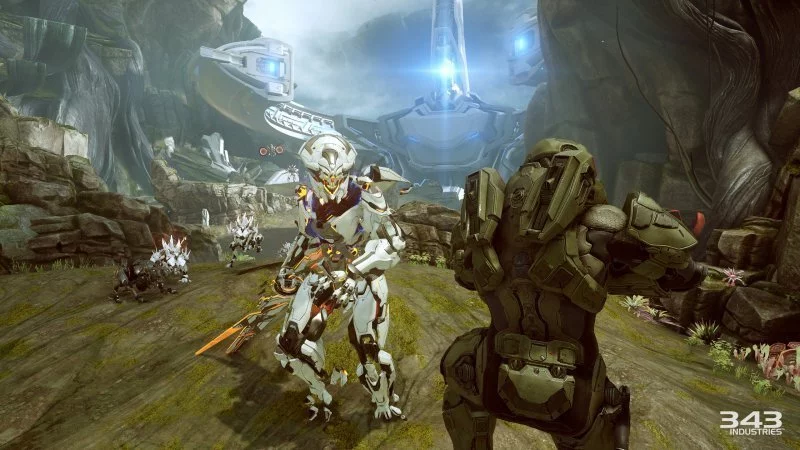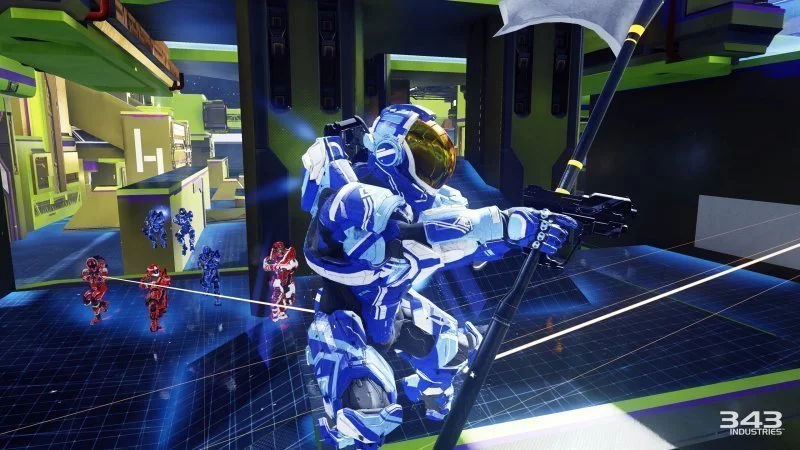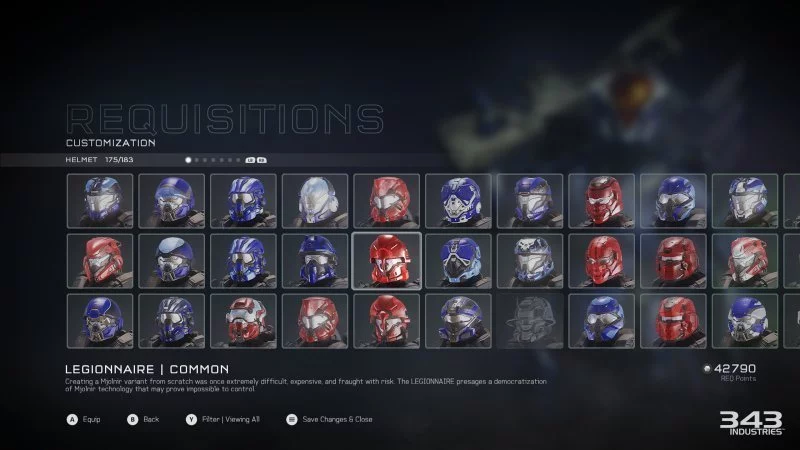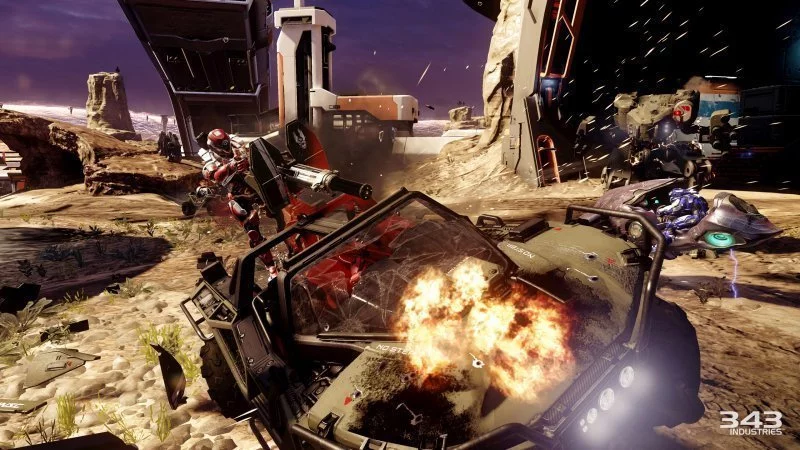Halo games were the epitome of console shooters for a long time. Halo: Combat Evolved was the first game to really play to the strengths and weaknesses of a gamepad instead of a mouse and keyboard, slowing combat down and taking advantage of improved vehicle controls. Fifteen years on, Halo still feels like its own game — resistant to the tropes of modern and open world shooters, for better or worse. In the moment, it still plays like a Halo game — and thus, is still a whole lot of fun — but this old dog would do well to learn some new tricks.
Halo 5: Guardians follows a familiar path: you’ll trudge through restrictive corridors on your way to open arenas where the series’ trademark combat can shine. That combat is as great as ever, its meaty gunplay and moment-to-moment battles enhanced by both squad mechanics that remove some of the fear of death alongside improved mobility through a Titanfall-like rocket boost and clamber. Weapon variety is skewed toward multiplayer-inspired scoped rifles when compared to previous Halo games. You’ll be forced to scavenge weapons from the battlefield, exposing you to Guardians‘ entire arsenal — of which both human and Promethean shotguns are particularly satisfying.
Every mission features a squad of four Spartans who will preferably be controlled by your friends. Should you have to rely on the AI, you will sometimes find them to be frustrating. In lieu of instant death, your armour merely “locks” — a quick hold of the X button from one of your buddies will have you back in the fight. Playing on higher difficulties, get used to spending your final moments watching AI companions get stuck on the environment, heading head-first into heavy fire or — worst yet — standing over your prone body doing nothing. To their credit, they’re capable enough medics on normal difficulty and below.
Your AI partners are also reasonable combatants and can be assigned particular targets or locations allowing you to make flanking moves or focus on particular enemies. There are limits; telling your buddies to attack a Hunter or Knight then going your own way will usually turn out poorly, but in regular combat they hold their own. Again, the higher difficulty selected, the less effective they’ll be. It’s not even worth attempting a Legendary playthrough without four human beings; the AI will only trip you up and slow you down. You’ve got to run every mission with four players, AI or not — so try to run with humans when you can.
Using AI, I felt I was being followed by a pack of armoured Saint Bernards for most of the game, there to offer me a sip of life whenever I fell, or to fill the dead air with combat barks as I traversed the landscape. Gears of War was more ambitious with how it used a squad, and that game is a decade old. In Guardians, you won’t split your squad to take divergent paths or even offer covering fire as they attack a mission objective. For what is on the surface a monumental change, this feels a lot more like the old co-op modes where a replica Master Chief magically appeared to help along the way. For some this will be a relief — this is most certainly your Dad’s Halo — but anybody expecting a new dawn for the series with complex squad interactions will be disappointed.
Halo 5 features some inspired combat arena design but regrettably there are too many boring stretches of Forerunner architecture that feel (and play) like padding. It leads to a lot of lazy design choices; too often you will be funneled into an arena and not allowed passage onward until it is cleared of hostiles without any real reason for the restriction. For every great scene charging up a hill at fortified Promethean positions there is one where you battle waves of troops in a dull arena full of grey ramps. A couple of the game’s fifteen levels basically involve walking around a map. Yawn.
Many times, Guardians reached for the chance to present an iconic moment in the series, but never quite got there. One mission attempts to recreate Halo 3‘s dramatic sequence of boarding and destroying a Scarab. Guardians‘ set piece was bigger, but it didn’t capture what made that original sequence so memorable. Vehicle sections never reach the heights of Halo 2‘s Metropolis but still punctuate the action nicely — especially when you jump in the mech-like Mantis.
Halo 5 suffers from an increasing disconnect between what your characters can do in cinematics versus what the game lets you do. The opening cutscene is bombastic, presenting an epic orbital drop and lots of close-quarters combat that you have no hope of ever replicating. Later in the game, you get to take control of a similar charge down a collapsing building. There, the action hero drama goes missing when you are in control; it ends up feeling like a pale imitation of the first scene.
Rather than creating drama with moment to moment action, Halo 5 uses cutscenes to bolt it on. Its fluid combat and enemy behaviour will create some “Xbox record that” highlights, but they seem few and far between. When you watch Spartan Locke assassinate an Elite using moves you could only wish to pull off, it’s a stark reminder that Halo has always been happy to stick with what it knows. In the single-player campaign of Guardians, that is to its detriment.
The universe crafted by the Halo games, books, television shows and ARGs is nigh-on impenetrable at this point; Halo 5 jumps straight into the middle of it. Its story is presented well enough that you can get by with minimal knowledge. Still, many of Guardians‘ characters were introduced in the extended universe and those who haven’t kept up will spend a lot of time tuned out.
Halo is no longer the story of the Master Chief; he is merely a player in a larger tale. Your times in control of the Chief feel more like cameos — Spartan Locke and his Osiris squad are now Halo‘s stars. It’s all a bit paint-by-numbers — the best mid-game cliffhanger is resolved by inference a few hours later and it’s painfully clear that Guardians is the middle act of a greater story.
A lot of the most interesting story beats are hidden in collectible intel drops, a long running and infuriating aspect of the Halo universe. What 343 calls “longevity”, I describe as the act of spending far more time than I should checking corners and crevices for data pads and terminals. This collect-a-thon is at odds with the “leisurely haste” 343 Industries uses to progress you through levels. You will always be rushing to catch somebody or escape something, but the haste is merely that: an illusion.
One early set piece sees you defending a ship as you wait for it to refuel. Turns out, the craft must be powered by the souls of dead Covenant as the only time refueling progresses is when an entire wave of enemies is defeated. It is a trick used over and over in Halo 5, and one that you can’t help but notice as you play. Trust me — that air support will wait for as long as it takes for you to clear out opposing anti-air turrets.
It is a credit to Guardians that in spite of these flaws I enjoyed my time with it. In an age of realistic shooters, it is nice to return to Halo and have the time to dodge incoming blue and orange projectiles. It’s a delight to get in close and melee, treating combat like a dance rather than a military engagement. If you are craving that iconic Halo style you won’t be disappointed, but don’t expect a revolution this iteration. It would be nice to see what a less-linear Halo game looks like, but 343 Industries has played it safe here and just delivered a tight Halo single-yet-four-player experience. It’s not the best in the series, not the worst, and best enjoyed with friends.
Thankfully, Guardians’ multiplayer more than makes up for the game’s underwhelming campaign. Halo 5 offers up multiplayer mayhem in two main modes: Arena and Warzone. Arena offers up the traditional Halo MP experience with the ability to jump straight into Slayer, Team Arena, SWAT, Free-for-all and the new Breakout mode. Warzone is the mode we previewed at E3, offering up a mix of PvE, PvP and zone control in a 12v12 format across three huge maps.
Slayer and Team Slayer are pretty standard fare, though 343 has changed things up by marking where and when special weapons will drop. This is a brilliant move for a number of reasons; those not as familiar with a map won’t be at a disadvantage to veterans, for one. More importantly, the markers mean maps usually have massive battle royales that occur when it comes time to pick up a dropped weapon. The Spartans’ new methods of traversal – the thruster pack and jump and clamber especially — open up myriad new opportunities when it comes to getting the jump on your opponent.
Breakout is a fast-paced and brutal new mode where teams of four compete against each other on rather skinny maps. Each player has one life per round, and rounds are either one by capturing a single flag or by eliminating the other team. The first team to win five rounds takes the match. Teamwork is absolutely essential in the mode, as is quick thinking and the ability to adapt. Because the rounds go so quickly, you’re always engaged and having fun. Breakout comes highly recommended. While it is in the normal Team Arena game rotation, you can also pick Breakout specifically from the main Arena menu.
The Team Arena playlist also features Strongholds, Halo’s zone control experience. Fun as hell, points are scored when one team controls two points at the same time. That fun diminishes when your teammates don’t realise they should play to that objective, instead focusing on killing the other team while they continue to pile on points. Capture the Flag is also a mainstay in the Team Arena playlists, and takes advantage of the same weapon markers as in Slayer. Finally, SWAT is like Slayer but without shields or motion trackers. Build up some experience before tackling this mode.
Warzone is a hectic experience that is made more confusing, initially, by the introduction of the REQ system. A new card-based feature, REQ packs provide cards that act as one-time consumables in Warzone or permanent cosmetic items like helmets and armours that can also be worn in Arena. Play in either main multiplayer mode earns REQ Points, which in turn can be used to buy Packs. Moreover, individual cards from REQ Packs can be sold if you don’t want to use them, providing more Points to buy another Pack with. Got all that?
Warzone itself is great fun, forcing your team of twelve to work together across multiple objectives. It’s best practice to clear AI enemies from your home base as quickly as possible at the start of the match, then moving to immediately control one of three points. From there, a major boss usually spawns; it’s best to immediately take that out before trying to secure a second point. The game is won when one team gets to 1,000 points – bosses usually offer up between 75 to 150 points depending on their difficulty. A round can also be one early by controlling all three map points and then destroying the other team’s home base core.
The mode is great fun, but the REQ system isn’t perfect. Huge weapons like Wraiths can be spawned around REQ level 5 or 6 – and your accessible REQ level increases with play — but they require a corresponding REQ card. There’s nothing more frustrating than being boxed in on your home base, being pounded by a Scorpion or the like, and having no cards to really retaliate with. Worse yet, in that situation, every death brings you down a REQ level or two, so even if you have a heavy vehicle card, you won’t be able to play it until you’ve “earned” the right to. It’s a small gripe in an otherwise pretty awesome experience.
There’s that whole slippery slope of whether or not the experience can be termed “play to win”, but we found that gameplay offered enough REQ Points that it wasn’t necessarily to even consider throwing extra money at the game.
Connection-wise, we’ve not had anything resembling the problems encountered in Halo: The Master Chief Collection’s multiplayer matchmaking. One issue with Warzone matchmaking can easily be corrected with this simple fix.
Ultimately, Halo 5: Guardians will live and die by its multiplayer content. Its single-player campaign is fun mainly because core Halo mechanics continue to be enjoyable. That said, Guardians is far from perfect and gamers not swayed by the Halo-ness of it will find it lacking. 343 has made great strides in their multiplayer game that lock in the title as a quality one, though it’s a shame that the single-player campaign is so too safe to really be considered ambitious.
 |
|
The good
|
The bad
|
Halo 5: Guardians was reviewed using a promotional code on Xbox One, as provided by the publisher. Click here to learn more about Stevivor’s scoring scale.
This article may contain affiliate links, meaning we could earn a small commission if you click-through and make a purchase. Stevivor is an independent outlet and our journalism is in no way influenced by any advertiser or commercial initiative.























